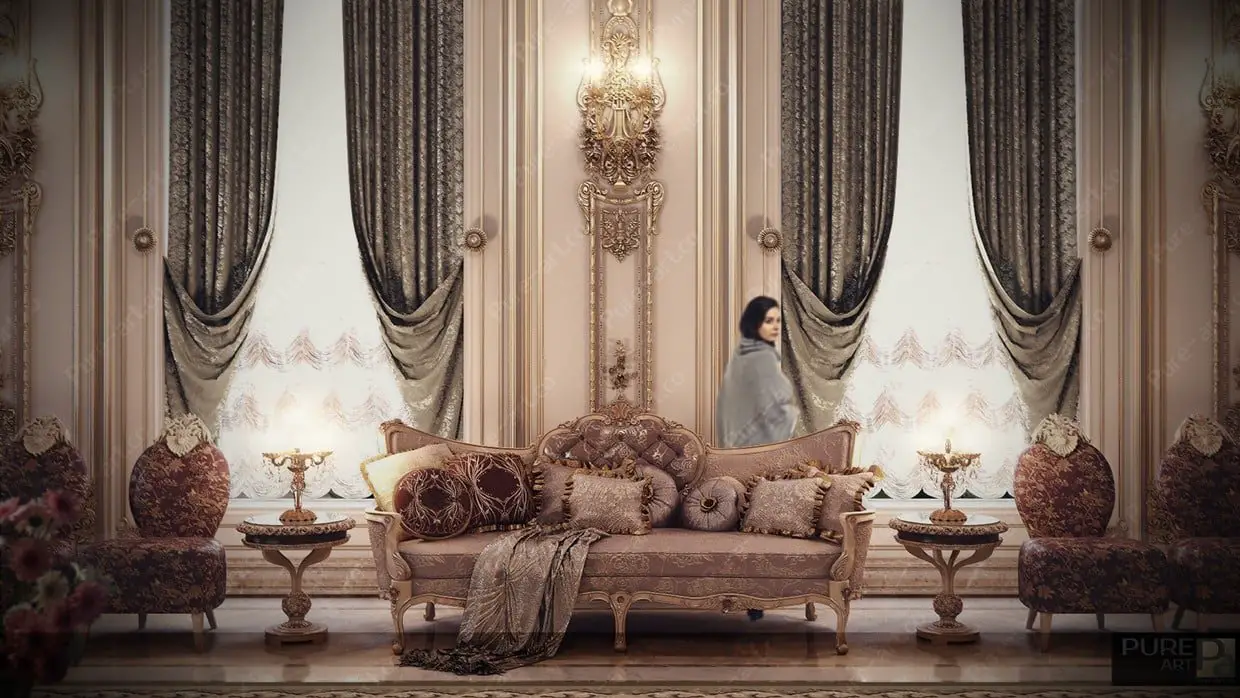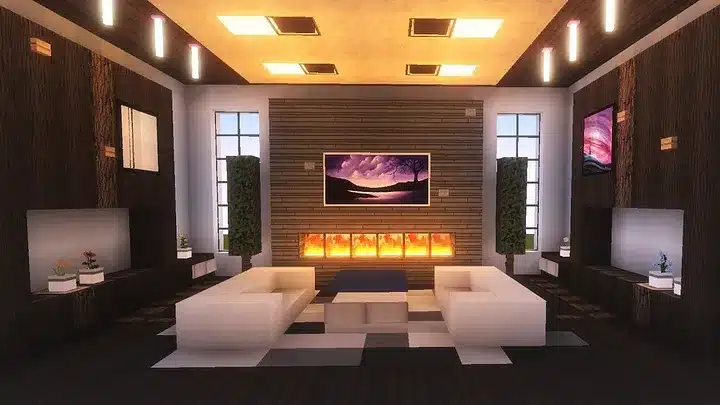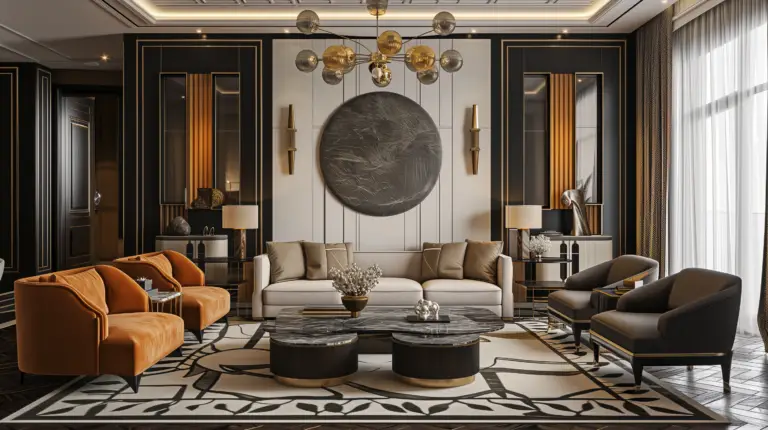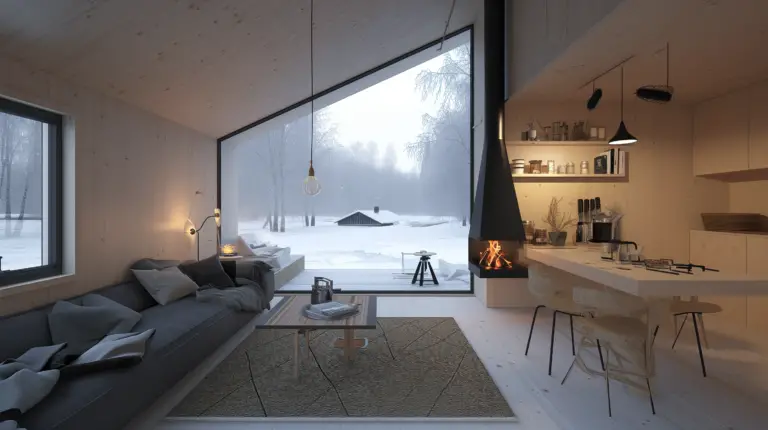Free Shipping On All Orders
Baroque Interior Design: Embracing Ornate Elegance

Imagine stepping back in time to an era synonymous with opulence and ornate design. The moment you enter the grand room, your eyes are drawn to intricate details and luxurious textures. This is the world of Baroque interior design, a style that emerged during the 17th century, leaving an indelible mark on the history of art and architecture.
Born as a reaction to the austerity of the Renaissance period, Baroque design captivated European courts with its extravagant sense of drama and bold contrasts. Notable for its curvilinear forms and elaborate embellishments, the style lends any space a sense of grandeur and elegance, effortlessly blurring the lines between illusion and reality. Baroque’s love for luxury made it a favorite amongst royals, with French King Louis XIV being amongst the most ardent admirers.
As you delve deeper into the world of Baroque interior design, prepare to marvel at the stunning architectural elements, ornate furnishings, and dazzling artworks that define this time-honored style. While rooted in history, Baroque still holds relevance today, offering timeless inspiration to those seeking beauty and extravagance in their surroundings. So, why not begin your journey into this fascinating world and uncover the secrets of Baroque style?
Dive into the opulent world of Baroque Interior Design and discover how this extravagant style has shaped the aesthetic landscape for centuries. Uncover the story behind its European roots, the powerful influence of the Catholic Church, and the dramatic flair that sets it apart from other design styles.
Baroque Interior Design History
European Influence
The Baroque period originated in 17th-century Italy, flourishing throughout Europe during the 17th and first half of the 18th centuries. This influential style was characterized by its energy, curvilinearity, and ornate detailing, which was the antithesis of the Renaissance’s emphasis on symmetry and balance. Baroque design spread across countries such as France, Germany, and even colonial South America, adapting regional characteristics and influences along the way.
Catholic Church
The Catholic Church played a significant role in the development of Baroque design. Following the Protestant Reformation, the Church sought a powerful visual language to inspire devotion and convey a sense of spiritual grandeur. Baroque design’s opulence and dramatic aesthetic were perfect in achieving this goal. Artists and architects were commissioned to transform the interiors of religious buildings into breathtaking displays of wealth and the divine, demonstrating the Church’s influence and dominance.
Drama
A core element of Baroque design is its inherent sense of drama. This theatrical quality is showcased through the interplay of light and shadow, rich textures and materials, and the use of illusionary techniques. Designers of this period were bold, often combining reality and illusion to create the ultimate immersive experience. Baroque’s dramatic nature made it a popular choice for palace interiors, as it conveyed a sense of power, luxury, and magnificence befitting the nobility of the time.
If you’re mesmerized by the opulence and grandeur of history, then the Baroque interior design style is where you’ll find your inspiration. This sumptuous design aesthetic encapsulates a time when every square inch of space commanded attention, while also being a testament to the skill and passion of artisans and architects who dared to push boundaries. Ready to dive deep into the splendor of Baroque interiors? Let’s embark on an alluring journey through the key characteristics of this lavish design style.
Key Characteristics of Baroque Design
Architecture and Ornamentation
Baroque architecture is characterized by its grandeur, with features like vaulted cupolas held up by swiveling colonnades, and walls and doorways crafted from a mix of rough stones and smooth stucco. In terms of ornamentation, Baroque style displays an abundance of gilded and gold accents, lavish decorative elements, and elaborate carvings that showcase the opulence and sophistication of the period.

Furniture and Fabrics
When it comes to furniture, Baroque design focuses on luxurious and intricately crafted pieces. Expect to find generously-sized chairs and sofas upholstered in rich, ornate fabrics such as silk, damask, or velvet. Gilded accents and carved details are found on tables, headboards, and cabinetry, highlighting the signature craftsmanship of Baroque furniture.

Colors, Patterns, and Textures
Dramatic, deep, and rich colors like maroon, midnight blue, and emerald green are commonly seen in Baroque interiors. Color schemes often include gold and silver accents, used to contrast and enhance the bold hues. Intricate patterns are a hallmark of Baroque design, with elements such as scrolling leaves, floral motifs, and architectural details found on walls, ceilings, and textiles to create visual interest and depth.

Lighting and Reflection
Baroque style puts a strong emphasis on grand lighting, typically featuring elaborate crystal chandeliers and wall sconces that generate a romantic and luxurious atmosphere. Mirrors are another crucial element in Baroque interiors, used for their ornate frames and ability to reflect light across the space, enhancing its overall opulence.

Now that you know the key characteristics of Baroque interior design, you’ve got the essential elements to recreate the striking beauty of this rich, captivating style in your own home.
Artistic Elements and Decorative Accents
Baroque interior design is synonymous with opulence and grandeur. From lavish paintings to intricate carvings, this unparalleled design style is a feast for the eyes. Let’s dive into the vibrant world of Baroque and explore the stunning artistic elements and decorative accents that make this style truly unforgettable.
Paintings and Frescoes
Baroque paintings and frescoes are characterized by their dramatic contrasts of light and shadow. Often, these artworks showcased biblical scenes and depicted intense emotions. Chiaroscuro, the Italian technique that blends light and dark tones, drove this contrasting style. Artists, such as Caravaggio and Artemisia Gentileschi, expertly employed this technique to create an immersive, almost theatrical experience.

Sculptures and Carvings
In the realm of Baroque sculptures and carvings, artists pushed the boundaries of realism. They crafted lifelike bronze sculptures, highlighting the intricate details of the human form. Gian Lorenzo Bernini, a prominent Baroque artist, is well-known for his impressive marble sculptures depicting dynamic movement and dramatic effects. Traditional materials such as marble and gold were often combined with stucco molding on ceilings and walls, contributing to the sense of opulence and grandiosity that define Baroque interiors.

Tapestries and Textiles
Rich textures and luxurious textiles are fundamental components in Baroque interior design. Tapestries adorned walls with intricate patterns and vivid colors, adding a touch of warmth and grandeur to any room. Silk and velvet were popular choices for upholstery, as they enhanced the overall opulent feel. Embellishments such as tassels, fringe, and gold threadwork were frequently used to adorn furnishings and textiles further, making each piece a work of art in its own right.

Are you ready to dive into the fascinating realm of Baroque interior design? If your answer is yes, keep reading as we unveil the styles and variations of this enchanting world that dominated the 17th and 18th centuries. As we embark on this journey through Italian Baroque, French Baroque, and Modern Baroque, you’ll witness the evolution of the style from its ornate origins to its contemporary adaptations.
Styles and Variations
Italian Baroque
In Italy, the birthplace of Baroque design, the style emerged in the 1600s as a reaction to the Catholic Church. Italian Baroque interiors showcase grand scale, complex forms, and curvilinearity. Features include intricate details, opulent materials, and domed architectural structures, adding a sense of power and beauty. Key elements of this design include:
- Scale: Large, expansive spaces with high ceilings
- Curvilinearity: Fancy, flowing lines and curves
- Complexity: Intricate carving, ornamentation, and detailing

French Baroque
French Baroque came to prominence with the reign of King Louis XIV, whose love for opulence shaped the style. The Palace of Versailles is the epitome of French Baroque design, with its detailed ornamentation, rich colors, and luxurious materials. Among the elements that set French Baroque apart are:
- Symmetry: Repeating patterns and themes throughout the space
- Contrast: Bold, dynamic color combinations
- Illusion: Trompe l’oeil techniques, creating a sense of depth and realism

Modern Baroque
Modern Baroque interiors preserve the essence of the original style, infusing it with contemporary design elements. Late Baroque and Rococo styles are often integrated into modern baroque spaces, maintaining the opulent and extravagant nature of classic Baroque. Features that define Modern Baroque include:
- Adaptability: Incorporating the Baroque essence into various styles
- Versatility: Paired with modern materials and technologies
- Individuality: Personalized interpretations of the traditional design

As you explore Baroque interior design further, embrace the drama and elegance of these styles and variations—their captivating charm may inspire your very own interior masterpiece.
Creating a Baroque Inspired Space
Have you ever dreamed of living in a space filled with opulence and drama? Baroque interior design might be the answer to that dream. With its grandiose elements, rich colors, and intricate details, achieving a Baroque inspired space can elevate the aesthetics of any room. Let’s explore how to effectively incorporate Baroque design elements and work with an interior designer to create your very own Baroque haven.
Choosing the Right Elements
When designing a Baroque inspired space, keep in mind the following key elements:
- Scale of Space: Baroque design features curvilinear forms and complex shapes. Plan your space accordingly to accommodate the grand scale of Baroque designs.
- Refined Interior Elements: Luxury is a hallmark of Baroque style. Opt for opulent materials, such as marble, velvet, and silk, to create a sophisticated atmosphere.
- Dynamism and Contrast: Use contrasting colors and patterns to highlight the intricate architectural features and play up the dramatic nature of Baroque design.
- Gilded Accents: Gold accents, such as gilded mirrors or furniture, can add richness to the space without overwhelming it.
- Stucco and Sculptures: Decorative stucco patterns and sculptures, particularly depicting women and children, can add an authentic touch to your Baroque inspired design.
Working with an Interior Designer
Partnering with a professional interior designer may be the key to truly capturing the essence of Baroque design. Here’s why:
- An interior designer can help ensure the cohesiveness of your Baroque vision. They can expertly combine elements from various sources while staying true to the unique Baroque aesthetic.
- With their experience and expertise, an interior designer can help you navigate the challenges of incorporating Baroque elements into your home, ensuring the result is both functional and visually stunning.
By keeping these tips in mind, you can successfully create a luxurious Baroque inspired living space that combines the opulence of seventeenth-century design with modern-day sensibilities. So why not delve into the world of Baroque interior design, and transform your home into a show-stopping work of art?

Impact and Legacy
The Baroque period had a profound impact on the interior design world, with its influence being felt even today. This artistic movement combined theatrical effects with grandeur and opulence to create a powerful emotional response in those who experienced it. Historically, the Baroque style was used to showcase wealth and power, and was favored by royalty and the elite. Today, Architectural Digest and other publications continue to spotlight Baroque interiors as examples of luxurious design.
The Baroque style brought drama and movement to interior spaces, employing rich colors, lavish textiles, and intricate detailing. Its influence is seen in modern design through the use of bold patterns, ornate moldings, and dramatic accents. Designers often integrate Baroque elements into contemporary settings to create a sense of opulence and visual interest.
One of the most important legacies of the Baroque period is its emphasis on creating an emotional connection between the viewer and the space. By carefully considering the effects of lighting, ornamentation, and layout, Baroque designers were able to evoke powerful feelings and transport their audience to a world of luxury and elegance. This approach to design has continued to evolve and be reinterpreted over the years, but the dramatic impact of Baroque interiors remains relevant to this day.
In conclusion, the impact and legacy of Baroque interior design is evident in the continued use of its defining elements, such as grandeur, drama, and opulence. As designers strive to create environments that elicit powerful emotional responses, the Baroque style continues to serve as an inspiration for contemporary design, showcasing the enduring appeal of its theatrical and luxurious aesthetics.
Have you ever walked into a room and felt immediately captivated by its sense of grandeur and drama? If so, you may have experienced the enchantment of Baroque interior design. A style born from the 17th and 18th centuries in Europe, Baroque design blends opulence, theatricality, and power to evoke an intense emotional response. Today, we’ll explore the impact and legacy of this influential movement and dive into its rich history and enduring appeal. Allow us to transport you to a world of stunning opulence and the ultimate in interior luxury.
Frequently Asked Questions
What is Baroque-style design?
Baroque interior design style is a decorative style that originated in Italy and France in the 17th and 18th centuries. It is characterized by ornate, elaborate, and grandiose designs that feature intricate details, curves, and dramatic effects.
What are the key features of Baroque interior design?
Baroque interior design is characterized by ornate, elaborate, and grandiose designs that feature intricate details, curves, and dramatic effects. It also features opulent materials like gold and marble, and bold color schemes.
How can I add Baroque style to my interior design?
To add Baroque style to your interior design, you can use ornate furniture, elaborate lighting fixtures, and grandiose decor pieces like mirrors and chandeliers. You can also use bold color schemes and opulent materials like velvet and silk.
If you liked this post about baroque interior design, don’t forget to follow us on Pinterest so you don’t miss any more interior design news!





